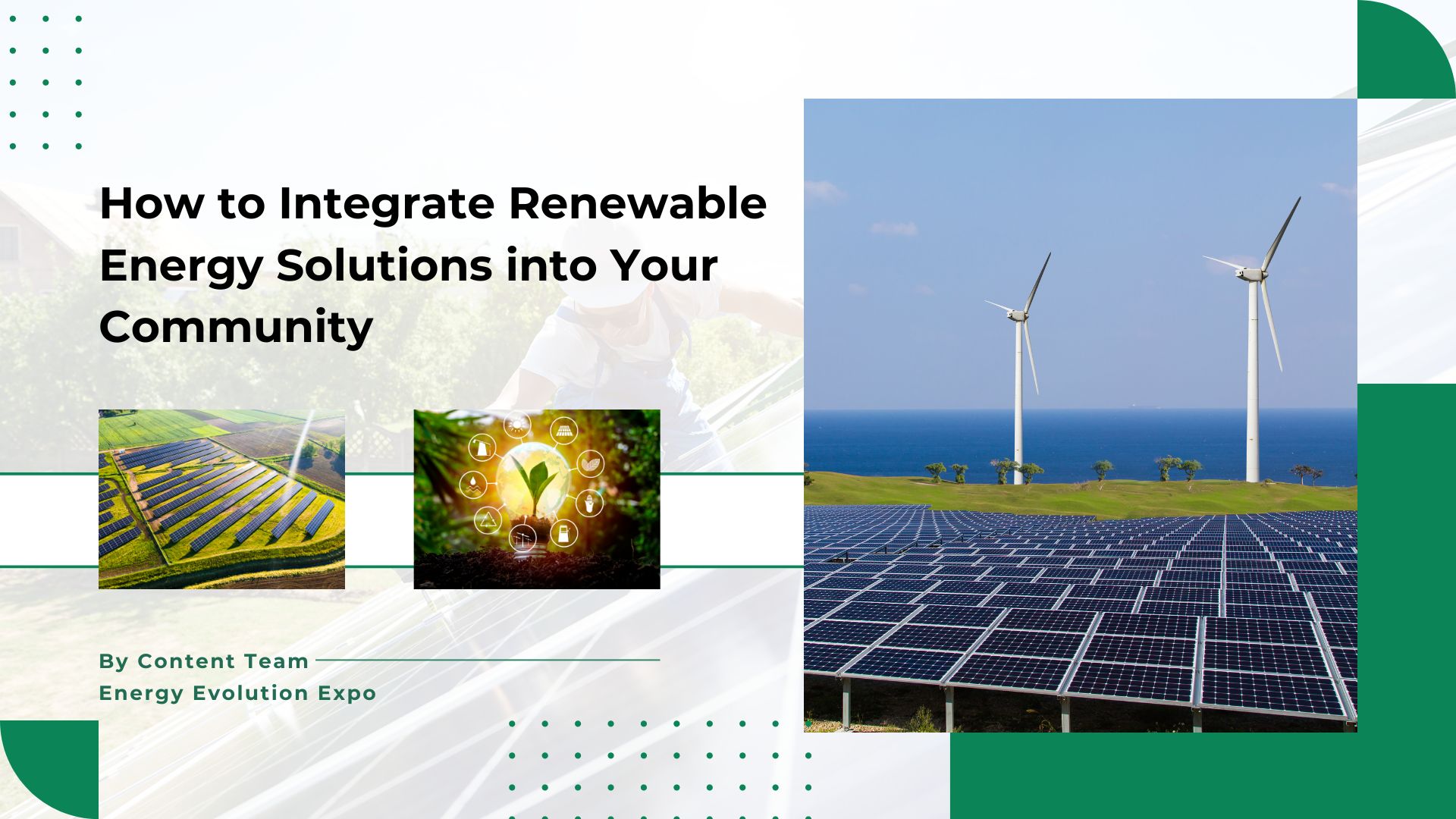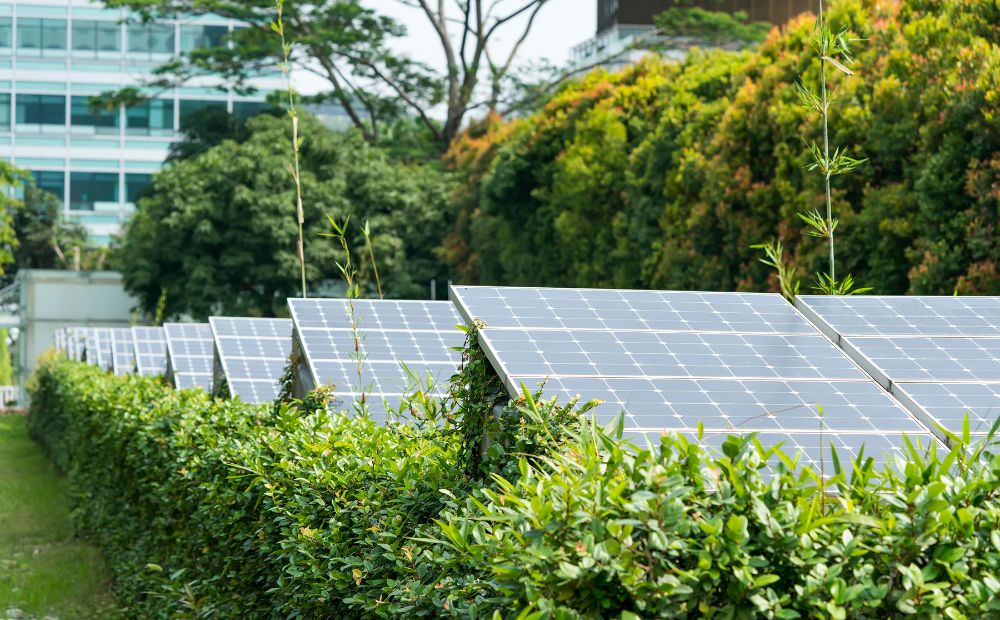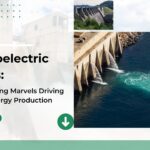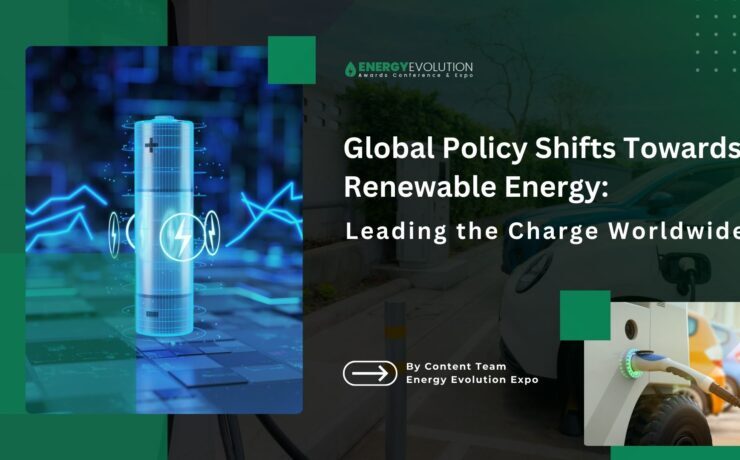How to Integrate Renewable Energy Solutions into Your Community

Renewable energy is more than just a popular term; it serves as a significant force that is altering the way in which communities generate and utilize energy. As worries about climate change increase and the availability of fossil fuels decreases, the incorporation of renewable energy options has become crucial.
This blog delves into the methods through which communities can include renewable energy solutions and showcases successful instances from various countries across the globe, such as the notable progress achieved by European nations. Renewable energy is derived from sources that are naturally replenishing and almost limitless.
The main types consist of solar power, which captures energy from the sun through photovoltaic (PV) panels or solar thermal systems; wind power, which transforms wind energy into electricity using wind turbines; hydropower, which produces power by harnessing the energy of moving water; biomass, which generates energy from organic materials; and geothermal energy, which utilizes the Earth’s internal heat.
Benefits of Renewable Enerfy Integration
Benefits of Renewable Enerfy Integration
Integration of renewable energy offers several advantages, including a reduction in greenhouse gas emissions, air pollution, and reliance on fossil fuels leading to lower environmental impact. It also stimulates economic growth by generating job opportunities in manufacturing, installation, and maintenance of renewable energy systems.
Furthermore, it enhances energy security by reducing dependency on imported fuels and boosting energy independence. Additionally, incorporating renewable energy sources contributes to improved air quality and a decrease in health issues associated with pollution, resulting in health benefits for individuals and communities.
Steps to Integrate Renewable Energy into Our Community:
1. Assess Local Resources and Needs
Evaluate the local environment to determine the most suitable renewable energy sources. For instance, communities with abundant sunlight may benefit more from solar power, while those in windy regions might focus on wind energy.
2. Engage Stakeholders and Educate the Community
Involve local government, businesses, and residents in the planning process. Education campaigns can help raise awareness about the benefits of renewable energy and how individuals can contribute.
3. Develop a Strategic Plan
Create a comprehensive plan that outlines goals, timelines, and necessary resources. Include policies and incentives to encourage investment in renewable energy projects.
4. Secure Funding and Investments
Explore funding options such as government grants, private investments, and public-private partnerships. Innovative financing models like community solar programs can also be effective.
5. Implement Pilot Projects
Start with small-scale projects to test feasibility and build community support. Successful pilots can pave the way for larger initiatives.
6. Monitor and Optimize
Continuously monitor the performance of renewable energy systems and make adjustments as needed. Engage the community in providing feedback and celebrating successes.
Global Examples of Renewable Energy Integration
Germany
Germany is a global leader in renewable energy, with its Energiewende (Energy Transition) policy aimed at phasing out nuclear power and significantly reducing greenhouse gas emissions. As of 2023, renewable energy sources, particularly wind and solar, account for nearly 50% of the country’s electricity consumption.
The German government provides substantial subsidies and incentives for renewable energy projects, fostering innovation and community involvement. Feldheim is renowned for being Germany’s first energy self-sufficient village. The village utilizes wind turbines installed on local farmland, solar panels, and a biogas plant that uses manure and crop residues from local farms. Additionally, they have a local district heating network powered by a wood-chip heating plant. The community collectively owns these energy resources, ensuring local economic benefits.
Wildpoldsried, Bavaria: Wildpoldsried has transformed into a model village for renewable energy, generating several times more energy than it consumes. The village uses a combination of wind turbines, solar panels, biogas plants, and small hydroelectric plants. Local farmers play a significant role by providing biomass for biogas production. The surplus energy generated is sold back to the grid, providing additional income to the community.
Freiburg im Breisgau, Baden-Württemberg: Known as Germany’s “Solar City,” Freiburg has heavily invested in renewable energy and sustainable urban planning. The city features numerous solar installations on public and private buildings, including the iconic Solar Settlement, a housing community where all homes produce more energy than they consume.
Freiburg also promotes energy-efficient buildings and has integrated renewable energy sources into public transportation and infrastructure. Jühnde is Germany’s first bioenergy village. The village operates a biogas plant that uses manure and silage from local farms, producing electricity and heat. The heat is distributed via a local district heating network. This project has significantly reduced the village’s carbon footprint and provided a sustainable energy solution.
Rhein-Hunsrück District, Rhineland-Palatinate district has become a leader in renewable energy, achieving energy self-sufficiency and exporting surplus energy. The district employs a mix of wind, solar, and biomass energy. Local wind farms generate significant electricity, and solar panels are widespread on residential and commercial buildings. Biomass plants utilize agricultural and forestry residues from the region.
Denmark
Denmark is renowned for its wind energy. The country has invested heavily in both onshore and offshore wind farms, resulting in wind power contributing to over 40% of its electricity consumption. Denmark’s success can be attributed to strong government policies, robust industry partnerships, and community ownership models where local residents can invest in wind projects. Samso Island is a prominent example of a community that has achieved 100% renewable energy for its electricity needs and significantly reduced its carbon footprint.
The island utilizes wind turbines, solar panels, and biomass. Onshore and offshore wind turbines generate surplus electricity that is exported to the mainland. Biomass plants use local straw for heating, and solar panels are installed on public and private buildings. The community actively participates in these projects, with many residents investing in and benefiting from the renewable energy infrastructure. Bornholm is aiming to become a carbon-neutral and sustainable island, known as “Bright Green Island. The island uses a combination of wind turbines, solar power, and biomass.
A significant portion of the island’s electricity comes from wind power. The district heating systems use locally sourced biomass, including wood chips and straw. Additionally, Bornholm is part of the EU-funded “EcoGrid” project, testing smart grid technologies to optimize renewable energy use and storage.
Middelgrunden Offshore Wind Farm: Located near Copenhagen, Middelgrunden is one of the world’s largest cooperatively owned wind farms. The wind farm consists of 20 turbines and produces around 89,000 MWh of electricity annually, supplying about 3% of Copenhagen’s electricity demand. Half of the wind farm is owned by a cooperative of local citizens, while the other half is owned by the municipal utility company, fostering local investment and community involvement in renewable energy.
The region of Thy and Mors is a leader in wind energy, with a high concentration of wind turbines. Local wind resources have been harnessed extensively, with wind turbines scattered across the landscape. Many of these turbines are community-owned, providing significant local income and energy independence.
The region is also experimenting with integrating wind energy with other renewable sources and storage solutions to create a stable and sustainable energy supply. Vejle is part of the “Energy Towns” initiative, aiming to become fossil-free by 2050. The municipality has invested in wind turbines, solar panels, and district heating systems using biomass. Local schools, businesses, and homes are encouraged to adopt energy-efficient technologies and renewable energy sources. The community actively participates in energy-saving initiatives and sustainability projects.
Spain
Spain is a frontrunner in renewable energy, particularly in solar and wind power. The country has implemented robust policies to promote renewable energy, leading to significant advancements. Spain’s solar power capacity is one of the highest in Europe, and its wind power industry is also well-developed, contributing to around 20% of the country’s electricity. Muniellos, a small village in Asturias, is known for its renewable energy initiatives.
The village uses a micro-hydroelectric plant that harnesses local water resources to generate electricity. Additionally, solar panels are installed on homes and public buildings. These initiatives have made Muniellos largely self-sufficient in terms of energy.Barcelona has implemented various renewable energy projects as part of its commitment to sustainability. The city has invested in solar energy, with solar panels installed on public buildings, including schools and sports centers.
The Barcelona Solar Ordinance requires new and renovated buildings to use solar energy for heating water. The city also uses biomass for district heating and cooling systems. Pamplona is part of the Navarre region, which is a leader in renewable energy in Spain. The region has extensive wind farms and solar parks. Pamplona itself uses a combination of solar energy, wind power, and biomass.
The city’s renewable energy projects are supported by local policies and community involvement, contributing to a significant reduction in carbon emissions. Murcia has integrated renewable energy into its urban planning and infrastructure. The region benefits from abundant sunshine, making solar energy a key resource. Solar panels are installed on public buildings, and the city promotes the use of solar energy in residential areas. Additionally, Murcia has invested in biomass and biogas plants that use agricultural waste from the region.
La Muela is known for its wind energy projects. The town has a large wind farm with numerous turbines generating electricity. The wind farm has brought economic benefits to the community, including job creation and revenue from energy production. Local involvement in the project has been significant, with many residents participating in and benefiting from the wind energy initiatives. Tenerife is working towards increasing its renewable energy capacity as part of the Canary Islands’ sustainability goals.
The island uses wind farms, solar panels, and a recently developed pumped hydro storage system. The Gorona del Viento project on nearby El Hierro island, which combines wind power with a pumped hydro storage system, serves as a model for similar initiatives in Tenerife. These projects help reduce the islands’ dependency on imported fossil fuels.

Sweden
Sweden aims to become one of the world’s first fossil fuel-free nations. The country generates most of its electricity from renewable sources, primarily hydropower and wind power. Sweden’s investment in bioenergy, particularly in the heating sector, is also noteworthy. The country’s policy framework and commitment to sustainability make it a leading example in Europe. Växjö aims to become fossil fuel-free by 2030 and has been dubbed “Europe’s Greenest City.
The city uses biomass from local forests for district heating and electricity. Växjö has extensive use of bioenergy plants that convert wood chips and other forestry residues into energy. The city also promotes energy efficiency and has installed solar panels on public buildings. Simris, a small village, is known for its pioneering microgrid project. The village uses wind and solar power combined with battery storage to create a self-sufficient energy system. Wind turbines and solar panels installed in the community generate electricity, and a battery storage system helps balance supply and demand.
This project has made Simris a model for renewable energy self-sufficiency. Malmö has numerous renewable energy initiatives as part of its goal to become a sustainable city. The Western Harbour district (Västra Hamnen) is a showcase for renewable energy and sustainable urban development.
The area uses solar panels, wind turbines, and geothermal energy. Buildings are designed to be energy-efficient, and the district heating system uses waste heat from industrial processes and biomass. Umeå is committed to becoming a carbon-neutral city by 2030. The city uses biomass for district heating and electricity, taking advantage of its proximity to vast forest resources.
Umeå also promotes the use of solar panels and has invested in energy-efficient public transport, including electric buses. Gothenburg has implemented various renewable energy projects to enhance sustainability. The city’s district heating system is one of the largest in the world and uses waste heat from industrial processes, along with biomass and biogas. Gothenburg also has a growing number of solar panel installations and promotes energy-efficient buildings. The city is developing a smart grid to optimize energy use and integrate renewable sources.
Gotland, an island in the Baltic Sea, aims to become a fossil fuel-free island. The island uses wind power extensively, with numerous wind turbines generating a significant portion of its electricity. Gotland also invests in solar energy and bioenergy. The island’s energy system is being upgraded to handle a higher share of renewable energy, including the use of smart grid technology.
Norway
Norway is a pioneer in renewable energy, with nearly all of its electricity generated from hydropower. The country’s commitment to sustainability extends to its electric vehicle adoption and plans to phase out fossil fuel use in various sectors. Norway’s experience demonstrates the feasibility of a predominantly renewable energy-based system. Oslo, the capital city, is a leader in sustainable urban development and renewable energy integration.
The city uses waste-to-energy plants to convert municipal waste into heat and electricity, providing district heating for thousands of homes. Oslo also invests in electric public transportation, including electric buses and ferries, and promotes the use of electric vehicles with an extensive charging infrastructure. For the Svalbard Project the remote archipelago of Svalbard is working towards reducing its dependence on coal and increasing renewable energy use.
Local Resources Used: Svalbard is exploring wind and solar energy potential. Wind turbines and solar panels are being tested to complement existing energy sources, aiming to create a more sustainable energy system for the island’s harsh Arctic environment. Årdal is known for its extensive use of hydropower, which supports both local energy needs and industrial processes. The town’s energy system is powered by nearby hydropower plants, which provide electricity for residential use and for the aluminum smelter that is a significant part of the local economy.
This integration of hydropower ensures a stable and renewable energy supply. Bergen has implemented several renewable energy projects as part of its climate action plan. The city uses hydropower for the majority of its electricity needs and has invested in wind energy projects in the surrounding areas. Bergen also promotes the use of electric vehicles and has a comprehensive public transportation system that includes electric buses and light rail.
Stavanger is focusing on renewable energy integration and smart city initiatives. The city uses hydropower for its electricity needs and has implemented solar energy projects, including solar panels on public buildings. Stavanger is also investing in smart grid technology to optimize energy use and integrate renewable sources more effectively. Tromsø is increasing its use of renewable energy to enhance sustainability in the Arctic region. The city relies on hydropower for electricity and is exploring additional renewable energy sources such as wind and solar. Tromsø also promotes energy efficiency in buildings and has implemented measures to reduce energy consumption in public infrastructure.
China
China, the world’s largest energy consumer, has made significant strides in renewable energy. The country leads in the production and installation of solar panels and wind turbines. By 2023, China had installed more than 1,000 gigawatts (GW) of renewable energy capacity, demonstrating its commitment to reducing carbon emissions and promoting sustainable development. Dezhou, Shandong Province: Dezhou, often referred to as China’s Solar City, has heavily invested in solar energy.
The city has widespread use of solar water heaters, solar streetlights, and solar panels on residential and commercial buildings. Dezhou hosts the world’s largest solar energy exhibition and has numerous factories producing solar technology, which has boosted the local economy and employment. Rizhao, Shandong Province: Rizhao is a pioneering city in using solar energy for urban and rural areas.
Over 99% of households in central Rizhao use solar water heaters, and solar energy is extensively used for street lighting, public facilities, and in agriculture. This has significantly reduced the city’s reliance on fossil fuels and lowered energy costs for residents. Dengkou has implemented a large-scale solar-wind hybrid power project. The region utilizes its abundant wind and solar resources to generate electricity.
The hybrid system ensures a stable power supply by compensating for the variability of each energy source. This project supports local energy needs and contributes to regional grid stability. Shanghai’s Minhang District has integrated renewable energy into urban planning.
The district uses solar panels on rooftops of residential and commercial buildings, solar street lighting, and a district heating system powered by biomass. Local policies encourage energy efficiency and the adoption of renewable energy technologies. Qinghai has achieved periods of 100% renewable energy usage, primarily using solar, wind, and hydroelectric power.
The province benefits from its high altitude and abundant sunlight, making it ideal for large-scale solar farms. Wind farms and hydroelectric plants complement solar energy, providing a reliable and continuous power supply. Qinghai’s renewable energy projects contribute to local development and environmental sustainability.
India
India has emerged as a global leader in renewable energy, with ambitious goals and substantial investments driving its transition to a greener future. The country’s diverse geography provides ample opportunities for harnessing various forms of renewable energy, making it a key player in the global renewable energy landscape.
India has one of the world’s largest and fastest-growing solar markets. The country’s National Solar Mission, launched in 2010, aims to achieve 100 GW of solar power capacity by 2022, and it has already made significant strides towards this goal. By 2023, India had installed over 60 GW of solar capacity, placing it among the top solar energy producers globally.
The state of Rajasthan, with its vast desert areas, is a prime location for large-scale solar projects. The Bhadla Solar Park in Rajasthan, one of the largest solar parks in the world, exemplifies India’s commitment to solar energy. This massive project, with a capacity of over 2.2 GW, showcases how India is leveraging its natural resources to generate clean energy.
India is also a major player in wind energy, with a target of 60 GW of wind power capacity by 2022. The states of Tamil Nadu and Gujarat are leading the way, hosting some of the largest wind farms in the country. By the end of 2023, India had over 40 GW of installed wind power capacity, contributing significantly to its renewable energy mix.
In addition to solar and wind, India is tapping into biomass and small hydropower resources. Biomass energy, derived from agricultural and forestry residues, is particularly important in rural areas, providing a sustainable energy source and helping to manage waste. Small hydropower
projects, which harness the energy of flowing water without large dams, are also being developed across the country, particularly in hilly regions.
Challenges and Solutions
Despite the benefits, there are challenges to integrating renewable energy:
High Initial Costs: The upfront investment for renewable energy infrastructure can be substantial. Solutions include government subsidies, low-interest loans, and innovative financing models like power purchase agreements (PPAs).
Grid Integration: Integrating renewable energy into existing grids requires upgrades and sophisticated management systems. Smart grid technologies and energy storage solutions can help manage intermittent supply and demand.
Public Perception and Resistance: Some community members may resist changes due to a lack of understanding or attachment to traditional energy sources. Effective communication, education, and demonstration projects can mitigate resistance.
Regulatory and Policy Barriers: Inconsistent or unfavorable policies can hinder renewable energy projects. Advocacy for supportive legislation and policy frameworks is essential.
Integrating renewable energy solutions into your community is a powerful step towards a sustainable and resilient future. By assessing local resources, engaging stakeholders, and learning from global examples, communities can develop and implement effective renewable energy strategies.
Countries like Germany, Denmark, India, China, Australia, and various European nations illustrate that with the right policies, investments, and community involvement, the transition to renewable energy is not only feasible but highly beneficial. Embracing renewable energy today will pave the way for a cleaner, healthier, and more prosperous tomorrow.
We need to keep up with all recent innovations to reap maximum benefits and to facilitate a better understanding of the latest developments and trends in the Renewable energy Industry, various Conferences and Expos, which bring Industry leaders together, serve as an all-inclusive platform.
The Energy Evolution Awards, Conference, and Expo organized by Next Business Media is making its debut in Spain in 2025. It will be a leading forum dedicated to honoring excellence in Energy Technology, showcasing innovations, and fostering collaborations. The events unite industry leaders, and visionaries to explore the latest advancements, tackle key challenges, and shape the future of Energy.
The Energy Evolution Awards, Conference, and Expo will celebrate outstanding achievements, promote sustainable practices, and drive the Energy Industry forward into a technologically advanced sustainable era. Energy Evolution Awards, Conference, and Expo will be a platform for cultivating innovation and shaping a brighter, more efficient energy landscape.





